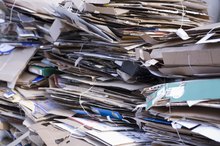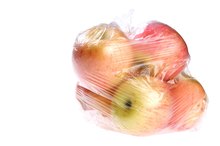Examples of Waste Recycling
The U.S. Environmental Protection Agency, or EPA, estimates that the amount of waste each American produces daily nearly doubled from 2.7 to 4.5 pounds between 1960 and 2008. Much of this waste contains toxic substances that pollute the environment and adversely affect human health. Recycling--turning waste material into useful products or resources--prevents pollution, conserves nonrenewable natural resources and reduces energy costs.
Compost
Compost is an organic material that adds nutrients to soil. People can use kitchen scraps and lawn detritus, such as grass clippings, to make compost, according to the University of Illinois Extension. Although many food scraps, including coffee grounds, vegetables, fruit, bread and egg shells, provide good compost material, people should avoid bones, fish, dairy products, meats, oils and fats, which create odor problems and attract pests, such as insects and small rodents. Homeowners can use mulching lawn mowers to reduce the size of grass clippings, which are a good source of nitrogen, and spread them back over the yard.
Metals
The Advantages of Biodegradable Products
Learn More
Metals are reusable natural resources. Manufacturers use metals, such as steel and aluminum, to produce household appliances, cars, construction materials and food and drink containers. Since metals retain their properties, they can be recycled indefinitely. In fact, about two-thirds of the aluminum ever produced is still in use, according to Earth 911, a nonprofit environmental group.
Glass
Glass provides packaging containers for diverse products, such as food, beverages and perfume. Soft drink, wine, beer, food and liquor containers provide the largest amount of glass for recycling, according to the EPA. Household products such as computers, wall insulation, kitchen tiles and countertops also contain glass components. According to Earth 911, Americans recycle approximately 13 million glass jars every day. Like metals, glass can be recycled endlessly.
Plastics
Benefits of Recycling Metal
Learn More
Plastics are synthetic polymers, which are substances composed of a chain of molecules--for instance, carbon, oxygen, hydrogen and silicon--hooked together. Plastics are components of countless products, such as electronics, furniture and beverage containers. U.S. residents used nearly 13 million tons of plastic containers and packaging in 2008, according to the EPA. Recycling plastic beverage containers greatly decreases the amount of discarded plastics in landfills and conserves natural resources.
Paper
Paper is the most common material in municipal solid waste, or MSW, commonly known as garbage or trash. Paper products accounted for about 31 percent of the solid waste stream in 2008, according to the EPA. Recycling paper reduces greenhouse emissions, saves landfill space, and reduces the need for cutting down more trees. Manufacturers can convert used paper into new paper products, which decreases the amount of wood needed during the process.
Related Articles
References
Resources
Writer Bio
Marci Sothern has written as a tutor in the academic field since 1999. She holds a bachelor's degree in history and a master's degree in political science from the University of Texas at Tyler. Her main areas of expertise include American history, comparative politics, international relations and political theory.









